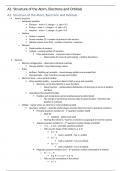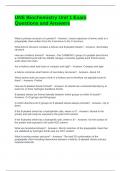A1: Structure of the Atom, Electrons and Orbitals
A1: Structure of the Atom, Electrons and Orbitals
Atomic structure
o Subatomic particles
Electron – mass = 0, charge = -1, spin = 0.5
Proton – mass = 1, charge = +1, spin = 0.5
Neutron – mass = 1, charge = 0, spin = 0.5
o Nucleus
Proton + neutron
Atomic number (Z) = number of protons in the nucleus
Relative atomic mass (Mr) = number of protons + neutrons
o Element
Fixed number of protons
Isotope = varying number of neutrons
Mass spectrometer – measures mass of isotopes
o Shows peaks for mass of each isotope + relative abundance
Electron
o Electron configuration – determines chemical reactivity
Occupy orbitals = have fixed energy values
o Rules:
Aufbau’s ‘building up’ principle – lowest energy orbitals are occupied first
Pauli principle – only 2 electrons occupy each orbital
o Electrons have – wave-particle duality
Wave-particle duality – a quantum object is both a wave and a particle
Electrons can be described by a wave function:
o Wave function – mathematical distributions of electrons in terms of position
and time
Heisenberg Uncertainty Principle
Position and momentum cannot simultaneously be determined
o The energy of an electron is known (due to spectroscopy) > therefore the
position is unknown
o Orbital – region where an electron is most probably located
Quantum numbers – describe orbital shapes and size (electrons have 4 quantum numbers)
Principle quantum number (n) –1 st quantum number (shell)
o Shell (n)
Subshell – within each shell
o How big the orbital is / how far an electron occupying it is from the nucleus
Angular quantum number (I) – 2nd quantum number (shape of orbital)
o I = 0, … n-1 (n = principle quantum number)
o Tells you the shape of the orbital (s, p, d, f)
S: I = 0
Each s subshell – has 1 s orbital
P: I = 1
Each p subshell – has 3 p orbitals
D: I = 2
Each d subshell – has 5 d orbitals
Magnetic quantum numbers (m1) – 3rd quantum number (orientation of orbital)
o m1 – -I, … +I
E.g. if I = 1, m1 = -1, 0, +1
o Tells you the orientation of the orbital
x = -1
, A1: Structure of the Atom, Electrons and Orbitals
y=0
z = +1
Spin quantum number (ms) – 4th quantum number (spin)
o Electrons have a spin – property of electron is related to angular momentum
ms = -0.5, +0.5
ms – +0.5 = clockwise rotation
ms – -0.5 = anticlockwise rotation
Pauli exclusion principle – no 2 electrons in an atom can have the same 4 quantum numbers
Max 2 electrons can share each orbital
o Same value of n
o Same value of I
o Same value of m1
o Different (ms) = different spin
Summary of quantum numbers
n (shell) I (shape) Orbital notation m1 (orientation) Orbital names
1 0 1s 0 1s
2 0 2s 0 2s
1 2p -1, 0, +1 2px, 2py, 2pz
3 0 3s 0 3s
1 3p -1, 0, +1 3px, 3py, 3pz
2 3d -2, -1, 0, +1, +2 3dxy, 3dyz, 3dzx,
3dx2-y2, 3dz2
Shape of orbitals (I)
o Wave functions:
Order of energies of orbitals – orbital further from
the nucleus = higher energy
Node = 0% chance of finding an electron
o More nodes = higher energy
Radial distribution function – how the probability of
finding an electron varies with distance from the
nucleus
1s2 electrons shield 2s1 electron from the
nuclear charge
o But: 2s radial distribution function
has a hump closer to the nucleus
than 1s
Resulting in an energy boost
for 2s1 = can penetrate than
1s2 orbital + spends more
time closer to the nucleus
2s1 closer to nucleus
= experiences a
stronger attraction –
energy is lowered
2p6 electrons radial distribution function = low probability of finding electron close
to nucleus
o 2p6 electrons do not penetrate 1s2 orbital as much = better shielded from
nuclear charge
Higher energy
Hund’s rule of maximum multiplicity





